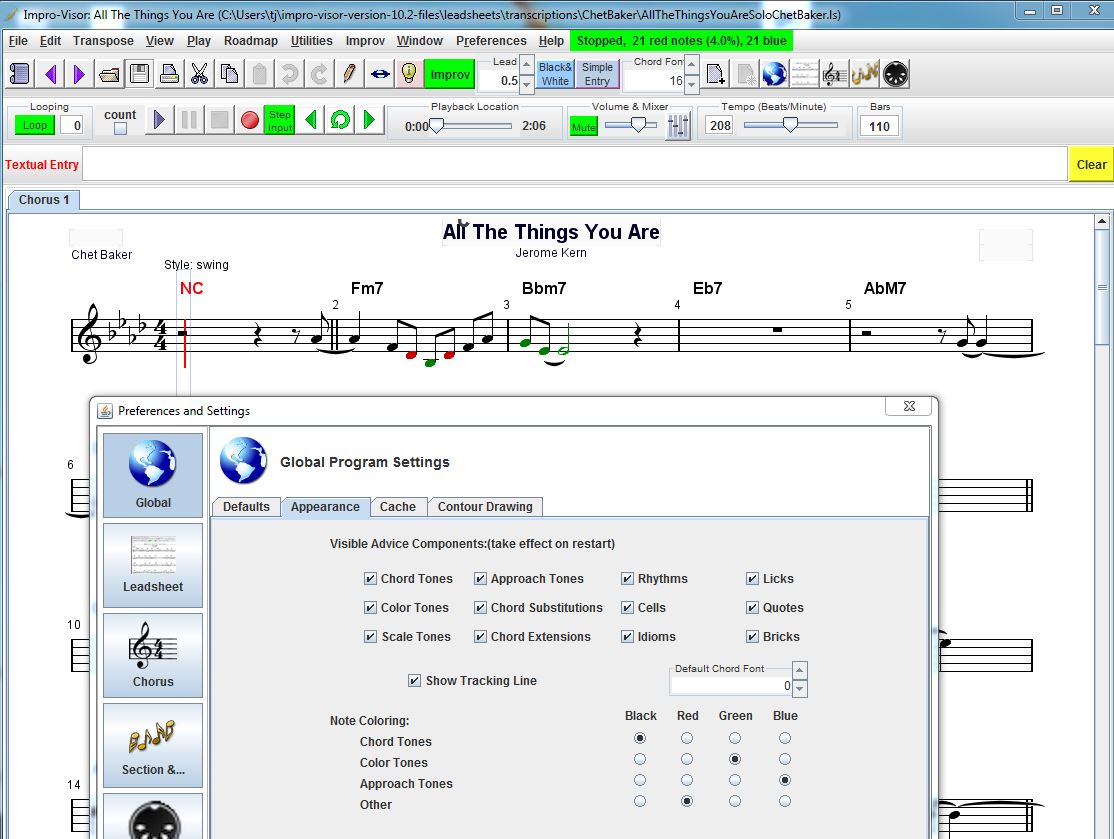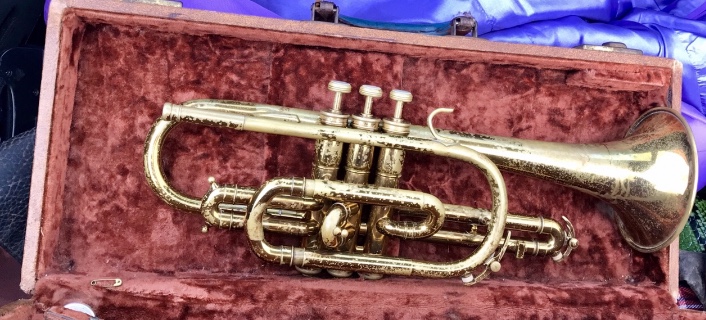@Dr-Mark wow, you don't see those on the App Store 
Posts made by tjcombo
-
RE: Practicing with dronesposted in Miscellaneous
-
RE: Arranger's Hell - brought to you by Antonio Jobimposted in Jazz / Commercial
@Dr-GO thanks for asking Gary. The gig was great - fantastic room, good crowd who enthusiastically responded. I still disappeared up a musical rat-hole on the solo, but I was probably the only one who noticed. I'm sure that you've confronted the dangers of over-thinking a piece of improv.
-
RE: Some good...."non-trumpeting" music :)posted in Lounge
@SSmith1226 Wow. What a line-up of legends. Thanks
-
RE: DIY Practice mute out of PET Coke bottlesposted in Mouthpieces & Accessories
@BigDub first of all props to you for having made a wooden trumpet. I've done enough wood turning to know that my wood-turning skills are not up to such a challenge. I can see two issues with turning a wooden mute - first the difficulty in turning such a thin-walled object (there, I've confessed my limitations), the second is the durability of the item. It would likely be pretty fragile. A fabricated wooden mute would have its own construction challenges but at least each wooden part would be cut such that t wasn't cross-grain.
But I do look forward to seeing any the outcome of you efforts... -
RE: Favorite Cornetposted in Flugelhorns & Cornets
@adc Wondering if the Studio cornets are as fine an instrument as that model trumpet. If so, you've had a great win. Also wondering if the Olds cornet mouthpiece is as horrible as their trumpet pieces

-
Useful free on-line course from Eastmanposted in Jazz / Commercial
Am currently enjoying a course provide by Coursera and would like to recommend it to TBers with an interest in playing/learning to play jazz, blues or simply expanding you knowledge on harmonic structures (beyond that which many of us have/had as players of a single tone instrument).
https://www.coursera.org/learn/the-blues
I'd previously bypassed this course because the abbreviated title "learn the blues" implied, in my mind, a simplistic overview of the genre. Happily, I was way wrong. The Blues: Understanding and Performing an American Art Form ranges widely from the origin of and foundation to much of our current music that the blues has given. From a practical point of view, the lessons provide good theoretical depth on harmonic structures along with practical take-aways. The starting point may be simple 12-bar blues as played by every guitarist and their dog, but delves into complex extensions such as those from Charlie Parker.
There are some great suggestions for ear-training technique, voice-leading, building/improving improv techniques and of particular use for wannabe key-boardists like me, comping techniques.
I could waffle on, but best that you take a look and form your own opinions,
For anyone that battled through the Gary Burton improv course on Coursera, I can say that this one is way more digestible with a lot of small elements that can be taken on board straight away.
About Coursera - there are two mode of using Coursera material - you can take a course for free, or pay to have an assessment and certificate at the end of the course.
Would love to hear from anyone who has had a look at this course.
-
RE: Some good...."non-trumpeting" music :)posted in Lounge
New meaning to the words "scarily good"...
-
RE: Practicing with dronesposted in Miscellaneous
@Kehaulani said in Practicing with drones:
@Kehaulani said in Practicing with drones:
@tjcombo said in Practicing with drones:
@kehaulani, sax players are as obsessed with various practice techniques as trumpet players are with mouthpieces.
The statement was not about obsessiveness with practicing, it was about relative humility.
Maybe trumpet players have less to be humble about?

...but, semi-seriously, trumpet feels like a "higher-risk" instrument than a lot of others. The sound draws attention, and a degree of confidence is needed to stand up and let it rip. Maybe sometimes with some trumpet players this confidence strays to the a*hole side of the line? Only sometimes mind you...
-
RE: Practicing with dronesposted in Miscellaneous
@pss Tampuri looks interesting (I thought it was a Japanese deep-frying technique
 ) Any sound source that generates complex harmonics and overtones can be used. The Drone Tool uses cellos.
) Any sound source that generates complex harmonics and overtones can be used. The Drone Tool uses cellos.@kehaulani, sax players are as obsessed with various practice techniques as trumpet players are with mouthpieces :-). I first heard about drones on a jazz podcast run by a sax player (10 minute jazz lesson podcast - worth a listen).
@ssmith1226 like you I was using Drone Tool for a while and have come back to it. The main driver for writing a post was noticing how relaxing it is to play over a drone. As well as the long tones, it's nice to play slow riffs, just listening to how the notes sound against the fundamental drone. Also cool to push notes sharp or flat and listen to the differential beating effect.
-
RE: Practicing with dronesposted in Miscellaneous
@administrator said in Practicing with drones:
I don't know, it seems it would be hard to fly one while you practice.

Nah.. easy with the "follow me" function. Could live stream your practice to Facebook.I'll spare the world my practice and pass on the above option.
-
Practicing with dronesposted in Miscellaneous
Wonder if any TBers use drones as part of your practice routine? Apart from the great ear training benefits, I find it to be like meditation for trumpet. Relaxing and a lot of fun.
There are plenty of apps and resources available. I'm happy with the Drone Tone app - the web page has an online drone tool that works in a browser http://www.dronetonetool.com/
There is a good overview of drone usage and benefits here https://billplakemusic.org/2015/08/30/a-highly-effective-and-really-fun-way-to-improve-your-ears/
-
RE: Interesting composition tool: Impro-Visorposted in Jazz / Commercial
@Kehaulani - I haven't used BIAB, but I'm not aware of any capability that it has to generate an improv line based on chords and melody that have been input. I am looking forward to getting my hands on BIAB in a couple of weeks (to make practise backing tracks) so will make a comparison.
Impro-Visor has an extensive range of tools to shape the improv lines that are generated. For example you can draw a line over a chart to "shape" a solo. There are functions that use deep learning/neural networks to understand styles that the user creates then improvise using those styles.
There has always been a problem of functionality vs ease of use for creators of computer programs. This is evident in I-V. So many tools, just a bit hard to navigate. I'll try to collect some sample output as I come to terms with the beast.
-
Interesting composition tool: Impro-Visorposted in Jazz / Commercial
I stumbled across an interesting piece of software last week - Impro-Visor is a tool to help improvising musicians generate ideas.
It looks like an academic project and has some quite sophisticated features for analysis of melodies or transcriptions. As I've just started to scratch the surface, I won't pass judgement on it at this stage, other than to warn you that, compared to modern score writing software, the interface is a bit of a pig - but the tools on offer look very interesting.
The screenshot below shows a transcription of a Chet Baker solo that is an included sample file. You can see that notes can be highlighted as chord tones, approach notes or "outside the changes". It appears that there is even a method for capturing audio although this requires extra modules.
Anyhow, it's all free and I'd be interested to hear if any of you have had a look at this? I'm using it on a Windows PC, but the website mentions Mac and Linux versions too.
If you try it, would love to hear your thoughts

-
RE: Buy your horns here, not there!posted in Classifieds
Have purchased a dozen or so horns via ebay from the US, shipped to Australia with (touch wood) no problems. USPS has been very reliable.
Direct transactions both single sample only with Hornucopia on a visit to the US and an online purchase from The Horn Trader indicates that they are both good to deal with.
-
RE: Favorite Cornetposted in Flugelhorns & Cornets
My favourite cornet today is this sweet old Martin Indiana which "saved my life".
My band had two slots -Sunday and Monday of a holiday weekend at a jazz festival an hour and a half drive from home. I normally stay for the whole weekend, but family matters prevented this. I arrived an hour before our slot, opened the hatch of my car to see no trumpet. Don't like leaving horns in a car.
Most of the bands with brass players had played on the previous days and had left town. Was walking from the car in my stupid purple suit when someone on the way to their gig said "great suit". I told him that I should've spent more time packing my instrument than dressing up. His keyboardist, a local, rocked up and said "I have an old trumpet upstairs". He returned with this baby.
It performed almost flawlessly. The first valve was sticking during a solo in Dm - fortunately you can hold down 1st and still make fair riff in Dm . No valve oil, so I had to make do with a bit of old school saliva on the valves
. No valve oil, so I had to make do with a bit of old school saliva on the valves 

-
RE: Waxing inside of MPposted in Repairs & Modifications
@adc another advantage - I understand that it takes longer for the hair to grow back when you wax.


-
RE: Remember when butchers wore a blue and white striped apron?posted in Repairs & Modifications
Chemical or ultrasonic cleaning, or even just a good wash can make a noticeable difference. So it'd be difficult to make an objective judgement on the effect of bead blasting given that it would be rare to blast without first cleaning, fixing and perhaps modifying a horn.
IMHO, if you like the look, just get it done. -
RE: Remember when butchers wore a blue and white striped apron?posted in Repairs & Modifications
@J-Jericho said in Remember when butchers wore a blue and white striped apron?:
@BigDub Actually, buffing does remove material, while glass beading removes deposits without harming the surface. It provides a smooth, satin finish by compressing the surface evenly. Among other things, this process works well with softer or thinner materials, such as plastic and rubber, or, of course, softer metals, such as brass and copper. It's also versatile enough to be used in finishing stainless steel, and "soft" is not a term used to describe that material!
Given that some people argue that the finish - lacquer, plating or not - impact the sound, I'm wondering if bead blasting would alter the temper of the metal and therefore characteristics of an instrument way more than buffing? Brass work-hardens very easily.
-
RE: Arranger's Hell - brought to you by Antonio Jobimposted in Jazz / Commercial
@Dr-GO and Kehaulani, thanks for your help on this one.
The Till Bronner solo is beautiful (not a bebop line in sight or sound :-)). It's so simple, yet masterfully done.We had our final rehearsal yesterday before next weekend's gig. I wrote out a few melodic ideas and some guide-tones on a chart and all went smoothly (and most of all musically :-)). If I get time this week will go through a similar exercise on some of the other pieces. It's certainly worth doing in tunes where the tonal centre constantly changes.
